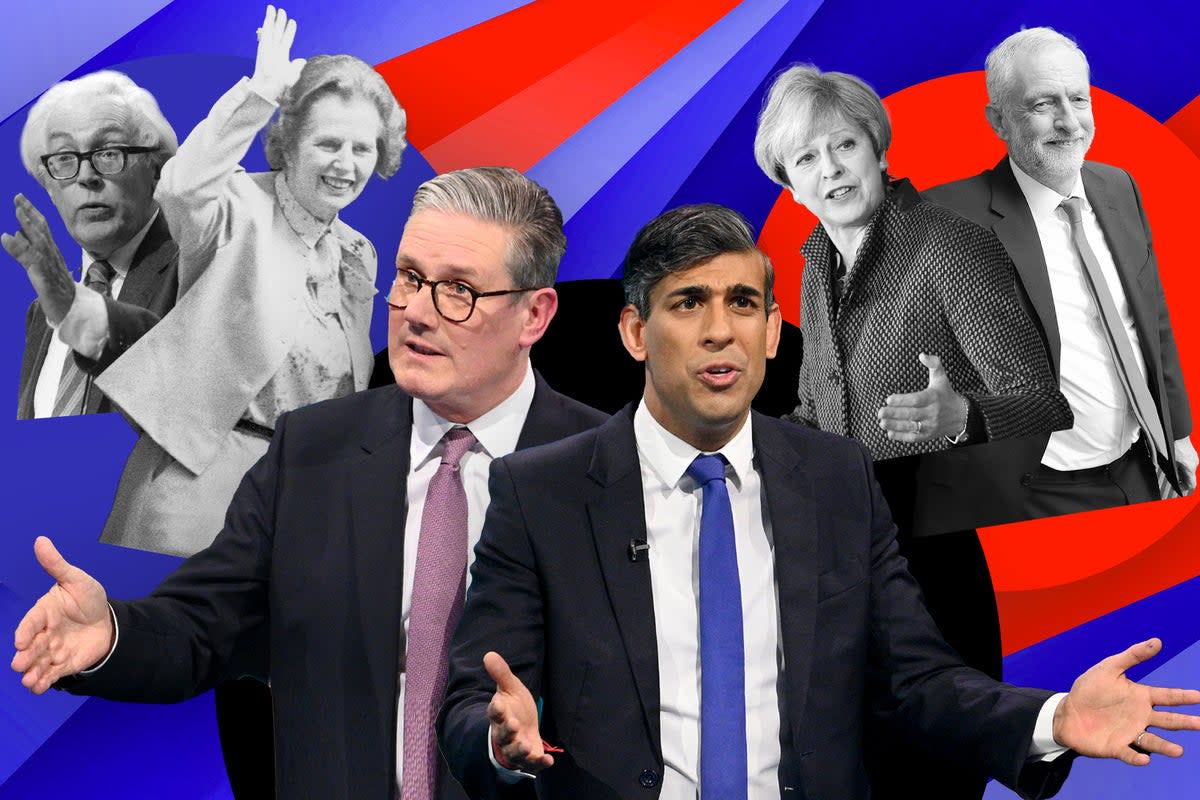General election countdown: What the 1983 and 2017 votes tell us about Starmer’s lead over Sunak

Ever since Rishi Sunak made his announcement in the rain in Downing Street, the election campaign has been characterised by an inability to budge Labour’s lead – but past contests suggest movement is still possible.
This week’s polls show a massive lead for Sir Keir Starmer, with the party at about 45 per cent and the Tories hovering around 20.
Labour has hopes of surpassing Tony Blair’s 1997 landslide victory.
But the game is not over yet. In 1983, a SDP-Liberal Alliance came from well behind to run Labour close for second place in the popular vote.
More recently, in 2017 the Tories’ 20-point lead seeped away under the challenge of Jeremy Corbyn’s Labour, and Theresa May was left to form a minority government.
With four weeks still to go, Tuesday’s fractious debate exposed weaknesses in both leaders and the introduction of Nigel Farage for Reform UK will shake up the maths in a number of constituencies.
Reform UK and the Lib Dems are a factor, currently polling at 12 per cent and 11 per cent respectively, according to Techne UK. That makes nearly a quarter of the popular vote shared between the two parties.
Lib Dem president and polling expert Dr Mark Pack said: “I think there is a difference for smaller parties like the Liberal Democrats, where the campaign can really make a difference to how many seats the party wins.
“But if you’re looking at Labour and Tories, whichever one of them starts ahead of the other is, historically, the overwhelming favourite to end up ahead at the end of it.”
In 1983, the SDP-Liberal Alliance, which later became the Lib Dems, came incredibly close to driving Labour out of its top-two spot in the vote share.
One month before the ballots, Labour was polling at 32 per cent – 14 points ahead of the Alliance. But that gap rapidly shrank in the final 30 days. In the end, the margin between the two parties was just two points; Labour won just 27.6 per cent of the vote and the Alliance won 25.4.
The first-past-the-post electoral system meant Labour was a distance ahead for the number of MPs – 209 to 23 – and Margaret Thatcher won a 144-seat majority but the Alliance threatened the 60-year dominance of the two parties.
The Social Democratic Party (SDP) had been formed in 1981, by the “Gang of Four” senior Labour figures as a more moderate left-wing party. It teamed up with the Liberal Party to form the Alliance, led by former Labour chancellor Roy Jenkins.
The Labour Party had swung to the left under Michael Foot, alienating some voters. The Alliance acted as a centre-left antidote for those deterred by his manifesto commitment for more “radical, socialist policies”.
In 2024 the Tories are very unlikely to win the election, but the scale of their loss matters, and Labour is not the only challenge.
Dozens of Tory seats are seriously threatened by smaller third parties, be that Reform, the Greens, or the Lib Dems, who are projected to win 48 seats by YouGov.
In June 2017, although Theresa May’s Tories came out as the biggest party with 318 seats, they received just 2.3 per cent more than Labour’s 40 per cent of the vote share.
Polls at the end of April 2017 had been showing a 23-point Conservative lead.
With her approval ratings high, Theresa May was criticised when she declined the TV debates, while the exposure saw Mr Corbyn’s support grow.
When Mrs May did appear on television in the final stretch of the campaign, the then-prime minister was seen as evasive on key issues – in particular the Brexit deal-or-no-deal debate.
Labour support rose from 26 per cent to 40 per cent in a matter of weeks, while the Lib Dem numbers shrank from 13 per cent to 7 per cent, following a trend of voters gravitating towards the two main parties as election day approaches.
Rishi Sunak undoubtedly has a mountain to climb ahead of 4 July, but history tells us it is more than possible the gap will close.


